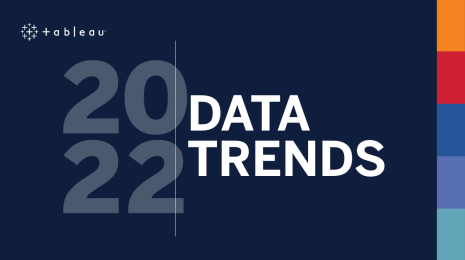The case for data communities: Why it takes a village to sustain a data-driven business
Editor's note: This article originally appeared in Forbes.
Data is inseparable from the future of work as more organizations embrace data to make decisions, track progress against goals and innovate their products and offerings. But to generate data insights that are truly valuable, people need to become fluent in data—to understand the data they see and participate in conversations where data is the lingua franca. Just as a professional who takes a job abroad needs to immerse herself in the native tongue, businesses who value data literacy need ways to immerse their people in the language of data.
“The best way to learn Spanish is to go to Spain for three weeks,” said Stephanie Richardson, vice president of Tableau Community. “It is similar when you’re learning the language of data. In a data community, beginners can work alongside people who know data and know how to analyze it. You’re going to have people around you that are excited. You’re going to see the language being used at its best. You’re going to see the potential.”
Data communities—networks of engaged data users within an organization—represent a way for businesses to create conditions where people can immerse themselves in the language of data, encouraging data literacy and fueling excitement around data and analytics.
The best data communities provide access to data and support its use with training sessions and technical assistance, but they also build enthusiasm through programs like internal competitions, user group meetings and lunch-and-learns. Community brings people together from across the organization to share learnings, ideas and successes. These exchanges build confidence and camaraderie, lifting morale and creating them around a shared mission for improving the business with data.
Those who have already invested in data communities are reaping the benefits, even during a global pandemic. People have the data training they need to act quickly in crisis and know where to go when they have questions about data sources or visualizations, speeding up communications cycles. If building a new data community seems daunting during this time, there are small steps you can take to set a foundation for larger initiatives in the future.

Data communities in a work-from-home world
Before Covid-19, organizations knew collaboration was important. But now, when many work remotely, people are disconnected and further removed from business priorities. Data and analytics communities can be a unifying force that focuses people on the same goals and gives them a dedicated space to connect. For businesses wanting to keep their people active, engaged and innovating with their colleagues, data communities are a sound investment.
“Community doesn’t have to be face-to-face activities and big events,” said Audrey Strohm, enterprise communities specialist at Tableau. “You participate in a community when you post a question to your organization’s internal discussion forum—whenever you take an action to be in the loop.”
Data communities are well suited for remote collaboration and virtual connection. Some traits of a thriving data community—fresh content, frequent recognition and small, attainable incentives for participation—apply no matter where its members reside.
Data communities can also spark participation by providing a virtual venue, such as an internal chat channel or forum, where members can discuss challenges or share advice. Instead of spending hours spinning in circles, employees can log on and ask a question, access resources or find the right point of contact—all in a protected setting.
Inside a data community at JP Morgan Chase
JPMorgan Chase developed a data community to support data activities and to nurture a data culture. It emphasized immersion, rapid feedback and a gamified structure with skill belts—a concept similar to how students of the martial arts advance through the ranks. Its story shows that, sometimes, a focus on skills is not enough—oftentimes, you need community support.
Speaking at Tableau Conference 2019, Heather Gough, a software engineer at the financial services company, shared three tips based on the data community at JPMorgan Chase:
1. Encourage learners to develop skills with any kind of data.
Training approaches that center on projects challenge learners to show off their skills with a data set that reflects their personal interests. This gives learners a chance to inject their own passion and keeps the projects interesting for the trainers who evaluate their skills.
2. Not everyone will reach the mountain top, and that’s okay.
Most participants don’t reach the top skill tier. Even those who only advance partway through a skill belt or other data literacy program still learn valuable new skills they can talk about and share with others. That’s the real goal, not the accumulation of credentials.
3. Sharing must be included in the design.
Part of the progression through the ranks includes spending time sharing newly learned data skills with others. This practice scales as learners become more sophisticated, from fielding just a few questions at low levels to exchanging knowledge with other learners at the top tiers.
How to foster data communities and literacy
While you may not be able to completely shift your priorities to fully invest in a data community right now, you can lay the groundwork for a community by taking a few steps, starting with these:
1. Focus on business needs
The most effective way to stir excitement and adoption of data collaboration is to connect analytics training and community-related activities to relevant business needs. Teach people how to access the most critical data sources, and showcase dashboards from across the company to show how other teams are using data.
Struggling to adapt to new challenges? Bring people together from across business units to innovate and share expertise. Are your data resources going unused? Imagine if people in your organization were excited about using data to inform their decision making. They would seek those resources rather than begrudgingly look once or twice. Are people still not finding useful insights in their data after being trained? Your people might need to see a more direct connection to their work.
“Foundational data skills create a competitive advantage for individuals and organizations,” said Courtney Totten, director of academic programs at Tableau.
When these efforts are supported by community initiatives, you can address business needs faster because you’re all trained to look at the same metrics and work together to solve business challenges.
2. Empower Your Existing Data Leaders
The future leaders of your data community shouldn’t be hard to find. Chances are, they are already in your organization, advocating for more opportunities to explore, understand and communicate with data. Leaders responsible for building a data community do not have to be the organization’s top data experts, but they should provide empathic guidance and inject enthusiasm.
These people may have already set up informal structures to promote data internally, such as a peer-driven messaging channel. Natural enthusiasm and energy are extremely valuable to create an authentic and thriving community. Find the people who have already volunteered to help others on their data journeys and give them a stake in the development and management of the community. A reliable leader will need to maintain the community platform and ensure that it keeps its momentum over time.
3. Treat Community Like a Strategic Investment
Data communities can foster more engagement with data assets—data sources, dashboards and workbooks. But they can only make a significant impact when they’re properly supported.
“People often neglect some of the infrastructure that helps maximize the impact of engagement activities,” Strohm said. “Community needs to be thought of as a strategic investment.”
Data communities need a centralized resource hub that makes it easy to connect from anywhere, share a wide variety of resources and participate in learning modules. Other investments include freeing up a small amount of people’s time to engage in the community and assigning a dedicated community leader. Some communities fail when people don’t feel as though they can take time away from the immediate task at hand to really connect and collaborate. Also, communities aren’t sustainable when they’re entirely run by volunteers. If you can’t invest in a fully dedicated community leader at this time, consider opening up a small portion of someone’s role so they can help build or run community programs.
4. Promote Participation at Every Level
Executive leadership needs to do more than just sponsor data communities and mandate data literacy. They need to be visible, model members. That doesn’t mean fighting to the top of every skill tree. Executives should, however, engage in discussions about being accountable for data-driven decisions and be open to fielding tough questions about their own use of data.
“If you’re expecting your people to be vulnerable, to reach out with questions, to see data as approachable, you can help in this by also being vulnerable and asking questions when you have them,” said Strohm.
5. Adopt a Data Literacy Framework
Decide what your contributors need to know for them to be considered data literate. The criteria may include learning database fundamentals and understanding the mathematical and statistical underpinnings of correlation and causation. Ready-made programs such as Tableau’s Data Literacy for All provide foundational training across all skill levels.
Data communities give everyone in your organization a venue to collaborate on complex business challenges and reduce uncertainty. Ask your passionate data advocates what they need to communicate more effectively with their colleagues. Recruit participants who are eager to learn and share. And don’t be afraid to pose difficult questions about business recovery and growth, especially as everyone continues to grapple with the pandemic. Communities rally around a common cause.
Explore the Tableau Data Community Toolkit to learn how to develop data communities and explore stories of data-driven collaboration.
Relaterade berättelser
Subscribe to our blog
Få de senaste Tableau-uppdateringarna i din inbox.








